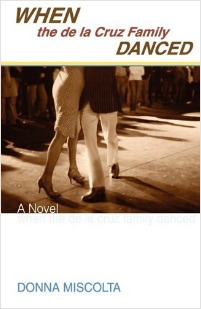|
by Dinah Roma Sianturi

Donna Miscolta, When the de la Cruz Family Danced, Signal 8 Press, 2011. 332 pgs. I am always suspicious of a writer's need to explore generational family sagas, to unearth secrets and to rely on the past to make sense of the present. Yet Donna Miscolta's debut novel When the de la Cruz Family Danced, a section from which was originally published in Cha, takes up the challenge of exploring the ties that bind a family together through time with subtle confidence. Hers is a seasoned dancer's ability to mesmerise, to bring the audience into a realm where there are no beginnings or endings, to make each step a deft marking of music, rhythm and harmony. But there is also the possibility of discord in the rests between the step and music, and it is during these instances when dancers should lose themselves even more to the music and to each other, and not to let go. In such moments, I find myself taking delight in the meanderings the dancers might offer. And meanderings are what one discovers in Miscolta's novel. It opens with the tentative Johnny de la Cruz visiting his estranged homeland, the Philippines, for a month—his one and only return visit. Between the tedious formalities of renewing family ties and acclimatising to the weather, he recalls why he originally left the Philippines after the Second World War and how this was linked to his yearning for the high school beauty, Bunny Bulong. Young Johnny's future had been set by his father, who felt that the only way his son could prosper was by enlisting him with the US Navy. That he did this by adding a year to his son's age only made Johnny's despair at leaving the Philippines and Bunny more poignant. Since leaving, forgetting is what has driven Jonny on—"As for Bunny, he made himself forget her, just as he made himself forget the Philippines, retaliation for having been sent away." Now back in the Philippines, Johnny's love is rekindled when a married Bunny visits him at a relative's home. This leads to a subsequent meeting at her place, where they succumb to the lost chances of the decades. The first chapter finishes with his goodbye to the country, but it is only the beginning of a sprawling tale of loss, renewal and acceptance that draws in those from far and near. The last paragraph of the chapter gives the readers a glimpse of what is to come: "As the plane left the tarmac, Johnny watched the distance open up between him and the land below….they were over the archipelago, its islands a jigsaw of sizes and shapes that defied piecing together. Then it was just the ocean." Throughout the rest of the novel, we will see that the various pieces of the de la Cruz family also defy piecing together. We return to Johnny as a sick man in the 1990s, solicitously surrounded by his wife, Tessie and three daughters. His daughter Josie's penchant for taking photos and salvaging home movies as videos encapsulates the patriarch's own view of memory: "Too often, they looked better than the lived experience (or at least the memory of it), leaving you with an alarming sense of loss." This ineffable feeling of loss and the absence of a son in Johnny and Tessie's union becomes crucial to the rest of the novel as the de la Cruz family confronts the sudden appearance of the nineteen-year-old Winston Pina, Bunny's only child. Right after his mother's death, Winston finds an unmailed letter bearing the name and address of Johnny de la Cruz. His search for the man who could be his father suddenly changes the dynamics in the de la Cruz household. Though this type of narrative turn can prove unwieldy, Miscolta's delicate prose and mindful style inject a controlled direction that sheds light on each of the characters' peculiarities. They do not simply become foils for or adjuncts to the protagonist. I can only think of them as capillaries—interconnected, each providing others life, yet at the same time needing to flow somewhere else, to be connect to someone else. Tessie, for instance, seeks the distraction of dance to replace the physical intimacy that has eroded from her relationship with Johnny after years of marriage and caretaking. Her frustration with her marriage is only exacerbated by the "hint of conspiracy" that permeates what Johnny and Winston do together; however, she cannot deny her husband the relationship as it provides the kind of male-bonding unavailable in an all-female household. Yet all these complexities and entanglements only render the characters too human to realise that what accumulates as memory is the quotidian, the grind of everyday life, no matter how tedious it becomes. It is also the tediousness of the present that makes one return to the abundant past for relief. But as the novel tells us, in our lives we are not afforded the fine lines between the past and present. It is a confluence—as Bunny's ubiquitous and disruptive letter attests to. The last of page of the novel tell us all we need to know about the letter and its effects: "Johnny knew that even if Tessie were to burn it or bury it or scissor it to shreds, Bunny was with them to stay….hadn't Bunny and Winston always been there in a way?" And it is at this point that Miscolta's ingenuity comes through: it wasn't forgetting that was Johnny's retaliation for being sent away, but not forgetting. |